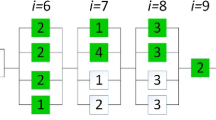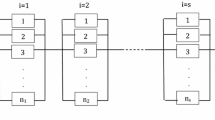Abstract
Communication has a remarkable and strategic role for the success of every enterprise. Nowadays, computer networks can be used as efficient tools to create connections between departments of an organization and to communicate with customers. Therefore, it is crucial for companies with IT-based activities to use computer networks so as to increase their efficiencies. In this paper, a bi-objective mathematical formulation is proposed for server farms. A server farm is a cluster of computer systems connected together to provide services to an organization and its customers. This model optimizes reliability and cost of server farms, concurrently. This problem is called the redundancy allocation problem that belongs to the class of NP-hard problems. Therefore, three meta-heuristics namely non-dominated sorting genetic algorithm II, pareto envelope-based selection algorithm II, and strength pareto evolutionary algorithm II have been hired to obtain feasible solutions in a reasonable computation time. To evaluate the performances of meta-heuristic methods, the ε-constraint method as an exact algorithm has also been used. The outputs demonstrate appropriate effectiveness of the employed algorithms.







Similar content being viewed by others
References
Afruzi E, Najafi AA, Roghanian E, Mazinani M (2014) A multi-objective imperialist competitive algorithm for solving discrete time, cost and quality trade-off problems with mode-identity and resource-constrained situations. Comput Oper Res 50:80–96
Agarwal M, Sharma VK (2010) Ant colony approach to constrained redundancy optimization in binary systems. Appl Math Model 34:992–1003
Ardakan MA, Zeinal Hamadani A (2014) Reliability–redundancy allocation problem with cold-standby redundancy strategy. Simul Model Pract TH 42:107–118
Ardakan MA, Zeinal Hamadani A, Alinaghian M (2015) Optimizing bi-objective redundancy allocation problem with a mixed redundancy strategy. ISA T 55:116–128
Baradaran V, Shafaei A, Hosseinian AH (2019) Stochastic vehicle routing problem with heterogeneous vehicles and multiple prioritized time windows: mathematical modeling and solution approach. Comput Ind Eng 131:187–199
Bulfin RL, Liu CY (1985) Optimal allocation of redundant components for large systems. IEEE Trans Reliab 34:241–247
Caserta M, Vob S (2016) An exact algorithm for the reliability redundancy allocation problem. Eur J Oper Res 244:110–116
Chambari AH, Rahmati SHA, Najafi AA, Karimi A (2012) A bi-objective model to optimize reliability and cost of system with a choice of redundancy strategies. Comput Ind Eng 63:109–119
Chang KH, Kuo PY (2018) An efficient simulation optimization method for the generalized redundancy allocation problem. Eur J Oper Res 265:1094–1101
Chern MS (1992) On the computational complexity of reliability redundancy allocation in a series system. Optim Lett 11:309–315
Corne DW, Jerram NR, Knowles JD, Oates MJ (2001) PESA-II: region-based selection in evolutionary multi-objective optimization. In: Proceedings of the genetic and evolutionary computation conference (GECCO), pp 283–290
Deb K, Tiwari S (2008) Omni-optimizer: a generic evolutionary algorithm for single and multi-objective optimization. Eur J Oper Res 185:1062–1087
Deb K, Agrawal S, Pratap A, Meyarivan T (2000) A fast elitist non-dominated sorting genetic algorithm for multi-objective optimization: NSGA-II. In: Schoenauer M et al (eds) Parallel problem solving from nature PPSN VI. PPSN 2000. Lecture notes in computer science, vol 1917. Springer, Berlin
Dolatshahi-Zand A, Khalili-Damghani K (2015) Design of SCADA water resource management control center by a bi-objective redundancy allocation problem and particle swarm optimization. Reliab Eng Syst Safe 133:11–21
Ebrahimipour V, Asadzadeh SM, Azadeh A (2013) An emotional learning-based fuzzy inference system for improvement of system reliability evaluation in redundancy allocation problem. Int J Adv Manuf Tech 66:1657–1672
Fyffe DE, Hines WW, Lee NK (1968) System reliability allocation and a computational algorithm. IEEE Trans Reliab 17:64–69
Garg H, Sharma SP (2013) Multi-objective reliability-redundancy allocation problem using particle swarm optimization. Comput Ind Eng 64:247–255
Hosseinian AH, Baradaran V (2019) An energy-efficient mathematical model for the resource-constrained project scheduling problem: an evolutionary algorithm. Iran J Manag Stud 12(1):91–119
Hosseinian AH, Baradaran V (2020) P-GWO and MOFA: two new algorithms for the MSRCPSP with the deterioration effect and financial constraints (case study of a gas treating company). Appl Intell. https://doi.org/10.1007/s10489-020-01663-x
Hosseinian AH, Baradaran V, Bashiri M (2019) Modeling of the time-dependent multi-skilled RCPSP considering learning effect: an evolutionary solution approach. J Model Manag (JM2) 14(2):521–558
Khalili-Damghani K, Abtahi AR, Tavana M (2013) A new multi-objective particle swarm optimization method for solving reliability redundancy allocation problems. Reliab Eng Syst. Safe 111:58–75
Khodemani-Yazdi M, Tavakkoli-Moghaddam R, Bashiri M, Rahimi Y (2019) Solving a new bi-objective hierarchical hub location problem with an M/M/c queuing framework. Eng Appl Artif Intell 78:53–70
Kulturel-Konak S, Smith AE, Coit DW (2003) Efficiently solving the redundancy allocation problem using tabu search. IIE Trans 35:515–526
Liang YC, Smith AE (2004) An ant colony optimization algorithm for the redundancy allocation problem (RAP). IEEE Trans Reliab 53:417–423
Maghsoudlou HR, Afshar-Nadjafi B, Niaki STA (2020) A framework for preemptive multi-skilled project scheduling problem with time-of-use energy tariffs. Energy Syst. https://doi.org/10.1007/s12667-019-00374-8
Mavrotas G (2009) Effective implementation of the ε-constraint method in multi-objective mathematical programming problems. Appl Math Comput 213:455–465
Mousavi SM, Alikar N, Niaki STA (2016) An improved fruit fly optimization algorithm to solve the homogeneous fuzzy series–parallel redundancy allocation problem under discount strategies. Soft Comput 20:2281–2307
Nahas N, Nourelfath M, Ait-Kadi D (2007) Coupling ant colony and the degraded ceiling algorithm for the redundancy allocation problem of series–parallel systems. Reliab Eng Syst Safe 92:211–222
Nakagawa Y, Miyazaki S (1981) Surrogate constraints algorithm for reliability optimization problems with two constraints. IEEE Trans Reliab 30:175–180
Onishi J, Kimura S, James RJW, Nakagawa Y (2007) Solving the redundancy allocation problem with a mix of components using the improved surrogate constraint method. IEEE Trans Reliab 56:94–101
Ouzineb M, Nourelfath M, Gendreau M (2008) Tabu search for the redundancy allocation problem of homogenous series–parallel multi-state systems. Reliab Eng Syst Safe 93:1257–1272
Rahimi S, Abdollahpouri A, Moradi P (2018) A multi-objective particle swarm optimization algorithm for community detection in complex networks. Swarm Evol Comput 39:297–309
Rahmati SHA, Hajipour V, Niaki STA (2013) A soft-computing pareto-based meta-heuristic algorithm for a multi-objective multi-server facility location problem. Appl Soft Comput 13:1728–1740
Ramirez-Marquez JE, Coit DW (2004) A heuristic for solving the redundancy allocation problem for multi-state series-parallel systems. Reliab Eng Syst Safe 83:341–349
Ramirez-Marquez JE, Coit DW, Konak A (2004) Redundancy allocation for series–parallel systems using a max–min approach. IIE Trans 36:891–898
Safari J, Tavakkoli-Moghaddam R (2010) A redundancy allocation problem with the choice of redundancy strategies by a memetic algorithm. J Ind Eng Int 6:6–16
Salmasnia A, Ameri E, Niaki STA (2016) A robust loss function approach for a multi-objective redundancy allocation problem. Appl Math Model 40:635–645
Schott JR (1995) Fault tolerant design using single and multicriteria genetic algorithms optimization. Master’s thesis, Department of Aeronautics and Astronautics, Massachusetts Institute of Technology, Cambridge, MA
Sooktip T, Wattanapongsakorn N, Coit DW (2011) System reliability optimization with k-out-of-n subsystems and changing k. In: 9th International conference on reliability, maintainability and safety (ICRMS). Guiyang, China. 12–15 June 2011
Tan Y, Tan GZ, Deng SG (2013) Hybrid particle swarm optimization with differential evolution and chaotic local search to solve reliability-redundancy allocation problems. J Cent South Univ 20:1572–1581
Veldhuizen V (1999) Multiobjective evolutionary algorithms: classifications, analyses, and new innovations. Ph.D. dissertation, Air Force Institute of Technology, Wright-Patterson AFB, Ohio
Wang C, Xing L, Amari SV, Tang B (2020) Efficient reliability analysis of dynamic k-out-of-n heterogeneous phased-mission systems. Reliab Eng Syst Saf 193:1–8. https://doi.org/10.1016/j.ress.2019.106586
Yazdani M, Zandieh M, Tavakkoli-Moghaddam R (2019) Evolutionary algorithms for multi-objective dual-resource constrained flexible job-shop scheduling problem. OPSEARCH 56:983–1006
Yeh WC (2018) A novel boundary swarm optimization method for reliability redundancy allocation problems. Reliab Eng Syst Saf. https://doi.org/10.1016/j.ress.2018.02.002
Zitzler E, Thiele L (1998) Multiobjective optimization using evolutionary algorithms: a comparative case study. In: Eiben AE, Bäck T, Schoenauer M, Schwefel HP (eds) Parallel problem solving from nature—PPSN V. PPSN 1998. Lecture notes in computer science, vol 1498. Springer, Berlin
Zitzler E, Deb K, Thiele L (2000) Comparison of multi objective evolutionary algorithms: empirical results. Evolut Comput J 8:125–148
Zitzler E, Laumanns M, Thiele L (2001) SPEA2: improving the strength Pareto evolutionary algorithm, Eidgenössische Technische Hochschule Zürich (ETH). Institut für Technische Informatik und Kommunikationsnetze (TIK). https://doi.org/10.3929/ethz-a-004284029
Author information
Authors and Affiliations
Corresponding author
Additional information
Publisher's Note
Springer Nature remains neutral with regard to jurisdictional claims in published maps and institutional affiliations.
Rights and permissions
About this article
Cite this article
Baradaran, V., Hosseinian, A.H. A bi-objective model for redundancy allocation problem in designing server farms: mathematical formulation and solution approaches. Int J Syst Assur Eng Manag 11, 935–952 (2020). https://doi.org/10.1007/s13198-020-01020-8
Received:
Revised:
Published:
Issue Date:
DOI: https://doi.org/10.1007/s13198-020-01020-8




